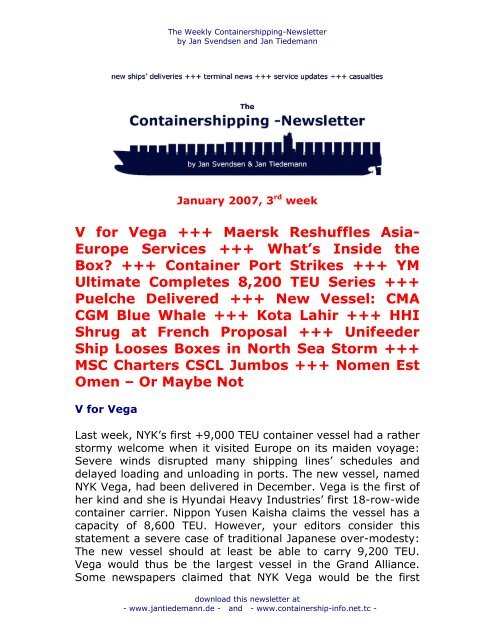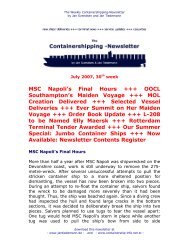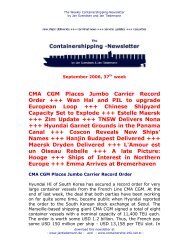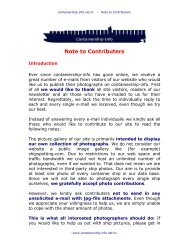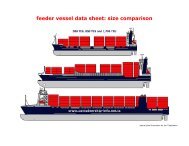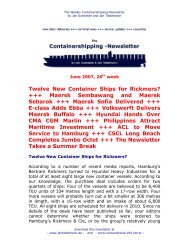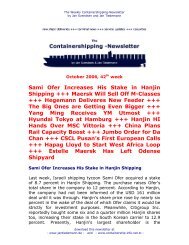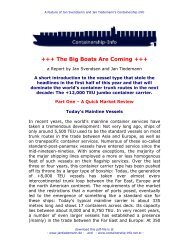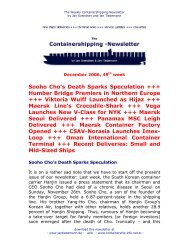Jan Svendsen and Jan Tiedemann - Containership-Info
Jan Svendsen and Jan Tiedemann - Containership-Info
Jan Svendsen and Jan Tiedemann - Containership-Info
Create successful ePaper yourself
Turn your PDF publications into a flip-book with our unique Google optimized e-Paper software.
The Weekly <strong>Containership</strong>ping-Newsletter<br />
by <strong>Jan</strong> <strong>Svendsen</strong> <strong>and</strong> <strong>Jan</strong> <strong>Tiedemann</strong><br />
<strong>Jan</strong>uary 2007, 3 rd week<br />
V for Vega +++ Maersk Reshuffles Asia-<br />
Europe Services +++ What’s Inside the<br />
Box? +++ Container Port Strikes +++ YM<br />
Ultimate Completes 8,200 TEU Series +++<br />
Puelche Delivered +++ New Vessel: CMA<br />
CGM Blue Whale +++ Kota Lahir +++ HHI<br />
Shrug at French Proposal +++ Unifeeder<br />
Ship Looses Boxes in North Sea Storm +++<br />
MSC Charters CSCL Jumbos +++ Nomen Est<br />
Omen – Or Maybe Not<br />
V for Vega<br />
Last week, NYK’s first +9,000 TEU container vessel had a rather<br />
stormy welcome when it visited Europe on its maiden voyage:<br />
Severe winds disrupted many shipping lines’ schedules <strong>and</strong><br />
delayed loading <strong>and</strong> unloading in ports. The new vessel, named<br />
NYK Vega, had been delivered in December. Vega is the first of<br />
her kind <strong>and</strong> she is Hyundai Heavy Industries’ first 18-row-wide<br />
container carrier. Nippon Yusen Kaisha claims the vessel has a<br />
capacity of 8,600 TEU. However, your editors consider this<br />
statement a severe case of traditional Japanese over-modesty:<br />
The new vessel should at least be able to carry 9,200 TEU.<br />
Vega would thus be the largest vessel in the Gr<strong>and</strong> Alliance.<br />
Some newspapers claimed that NYK Vega would be the first<br />
download this newsletter at<br />
- www.jantiedemann.de - <strong>and</strong> - www.containership-info.net.tc -
The Weekly <strong>Containership</strong>ping-Newsletter<br />
by <strong>Jan</strong> <strong>Svendsen</strong> <strong>and</strong> <strong>Jan</strong> <strong>Tiedemann</strong><br />
ship in a series of eight identical sister vessels. This is not quite<br />
correct. Actually, NYK will receive four identical ships from<br />
Hyundai Heavy as well as another series of eight similarly-sized<br />
ships from Japan’s IHI yard at Kure. Nippon Yusen Kaisha<br />
deployed the new ship to the Gr<strong>and</strong> Alliances Asia-Europe loop<br />
number four. The sling’s westbound port rotation includes<br />
Dalian, Xingang, Qingdao, Busan, Yang Shan, Ningbo,<br />
Singapore, Port Kelang, Jeddah, Rotterdam, Hamburg <strong>and</strong><br />
Southampton. NYK Vega measures 338.17m in length, 45.60m<br />
in width <strong>and</strong> has a summer draught of 14.50m. Her maximum<br />
deadweight is 103,000 tonnes. A 68MW 12-cylinder diesel<br />
engine drives the ship at up to 25 knots. Shortly before the new<br />
carrier premiered in northern Europe, NYK released the names<br />
of her next two sisters: NYK Venus will be delivered February<br />
<strong>and</strong> NYK Virgo will enter service in May. While NYK Venus is an<br />
entirely new name for the line, there has already been a<br />
containership named NYK Virgo in the past: A 1,613 TEU ship<br />
carried that name until 2002, when it was sold as ACX<br />
Marguerite. ACX is a member of the NYK group of companies,<br />
mainly involved in intra-Asian trade <strong>and</strong> employs ships in the<br />
size range from 500 to 2,300 TEU.<br />
NYK Vega, presently the largest ship in the Gr<strong>and</strong><br />
Alliance’s fleet, arrives at Hamburg for the first time.<br />
photo: <strong>Jan</strong> <strong>Tiedemann</strong><br />
download this newsletter at<br />
- www.jantiedemann.de - <strong>and</strong> - www.containership-info.net.tc -
The Weekly <strong>Containership</strong>ping-Newsletter<br />
by <strong>Jan</strong> <strong>Svendsen</strong> <strong>and</strong> <strong>Jan</strong> <strong>Tiedemann</strong><br />
Maersk Reshuffles Asia-Europe Services<br />
In last week’s newsletter we described the proposed port<br />
rotation of Maersk Line’s new – or rather reshaped – AE7 loop.<br />
The service is scheduled to be transferred into an all-E-class<br />
Asia-Europe sling. At the time went to press however, there<br />
was no confirmed list of all ports or call. Maersk Line meanwhile<br />
revealed that the new super loop will actually make<br />
intermediate calls at Tanjung Pelepas <strong>and</strong> Algeciras in both<br />
directions. Thus, the confirmed port rotation now reads:<br />
Ningbo, Xiamen, Hong Kong (w), Yantian (w), Tanjung Pelepas<br />
(w), Algeciras (w), Rotterdam, Bremerhaven, Algeciras (e),<br />
Tanjung Pelepas (e), Yantian (e), Hong Kong (e) <strong>and</strong> back to<br />
Ningbo. The AE7 will eventually be the biggest Asia-Europe loop<br />
<strong>and</strong> it will focus on southern China a feature <strong>and</strong> single call in<br />
China’s central coastal region (Ningbo). Simultaneously, the<br />
AE2 will be reshaped into a dedicated North China <strong>and</strong> Korea<br />
loop with no intermediate ports except for a Mediterranean call<br />
at Malaga. It will serve the ports of Busan, Kwangyang, Dalian,<br />
Xingang, Qindao <strong>and</strong> Yang Shan. The present AE1 loop will<br />
continue to directly serve Sc<strong>and</strong>inavia with calls at Aarhus <strong>and</strong><br />
Gothenburg. Changes on the ‘far end’ will bring calls at Yantian<br />
<strong>and</strong> Nansha (southern China) <strong>and</strong> Kobe, Yokohama <strong>and</strong><br />
Nagoya.<br />
What’s Inside the Box?<br />
Traditionally, the container ship used to be the beast of burden<br />
for manufactured products <strong>and</strong> goods of high value. Fuelled by<br />
the massive amount of new container capacity <strong>and</strong> the<br />
numerous new services that have become available in recent<br />
years, containers have increasingly started to attract other<br />
cargoes as well. For quite some time it has been a wellestablished<br />
practise to use containers to ship non-ferrous scrap<br />
metals like aluminium or copper between Europe, the US <strong>and</strong><br />
Far Eastern recycling companies. The same system has<br />
increasingly been applied to shredded recycling plastic. It is<br />
largely driven by the imbalances in most on the word’s mainline<br />
trades <strong>and</strong> the resulting low freight rates to Asia. American<br />
exporters have even started to ship agricultural bulk products<br />
like soy beans, grain or corn in st<strong>and</strong>ard forty-foot-boxes. The<br />
download this newsletter at<br />
- www.jantiedemann.de - <strong>and</strong> - www.containership-info.net.tc -
The Weekly <strong>Containership</strong>ping-Newsletter<br />
by <strong>Jan</strong> <strong>Svendsen</strong> <strong>and</strong> <strong>Jan</strong> <strong>Tiedemann</strong><br />
load is not being shipped in bags or smaller vessels, but as a<br />
true bulk cargo. Instead of using specialised (but expensive)<br />
silo containers, the loads are simply dumped in to st<strong>and</strong>ard<br />
boxes. Two years ago, five percent of all bulky agriculture<br />
exports from the U.S. were shipped in containers <strong>and</strong> the<br />
container’s growth rates in this field considerable. One<br />
noteworthy side-effect of the container transport in the change<br />
in the trading patterns. Some American Farmers have started<br />
to directly get in touch with buyers in the Far East, by-passing<br />
vendors <strong>and</strong> brokers as well as the necessity to get involved in<br />
the charter of bulk ships <strong>and</strong> cargo h<strong>and</strong>ling <strong>and</strong> storage.<br />
Container Port Strikes<br />
2006 was not only a record year in terms of container volumes,<br />
but also one with plenty of strike action among terminal<br />
workers <strong>and</strong> truck drivers. In Europe both ECT’s <strong>and</strong> Møller-<br />
Maersk’s Rotterdam terminals were negatively affected by dock<br />
worker strikes. Many ships skipped their Rotterdam call <strong>and</strong><br />
sailed straight into Hamburg. Others moved to Zeebrügge <strong>and</strong><br />
Antwerp. Disagreements about the conditions of work <strong>and</strong> pay<br />
had caused the disputes. South Korea’s main port of Busan on<br />
the other h<strong>and</strong> was paralysed by a strike of truck drivers.<br />
Hinterl<strong>and</strong> traffic broke down <strong>and</strong> the port was jammed with<br />
boxes when the truckers blockaded the port’s access roads. The<br />
blockade went on for some weeks until the payment issues<br />
were settled. A port that suffered much more, was<br />
Bangladesh’s only international port Chittagong. A month-long<br />
strike virtually cut the nation off of international trade. More<br />
than 50 ships were either waiting off or trapped within<br />
Chittagong <strong>and</strong> many shipping lines dropped all their<br />
Bangladesh-bound cargo in Inida. The container backlog in the<br />
trade to Chittagong has not even disappeared until today. The<br />
other end of the planet also got its share when strikes affected<br />
the port of Santos, Brasil. Weeks of chaos <strong>and</strong> heavy delays<br />
were caused by a strike of dock workers <strong>and</strong> truck drivers. The<br />
strike wave of 2006 finished with a seven-week labour dispute<br />
in Greece. Workers who opposed the privatisation of port<br />
operations brought the container terminals of Piraeus <strong>and</strong><br />
Thessaloniki to a st<strong>and</strong>still in the middle of the run-up to<br />
Christmas – a peak period for container transport. Some large<br />
download this newsletter at<br />
- www.jantiedemann.de - <strong>and</strong> - www.containership-info.net.tc -
The Weekly <strong>Containership</strong>ping-Newsletter<br />
by <strong>Jan</strong> <strong>Svendsen</strong> <strong>and</strong> <strong>Jan</strong> <strong>Tiedemann</strong><br />
liner operators like ZIM <strong>and</strong> MSC temporarily moved their<br />
activities to neighbouring countries. 2007 might soon see<br />
strikes in India, where the dock workers’ union <strong>and</strong> some local<br />
port authorities cannot upon working conditions. The existing<br />
agreement on tariffs ends on <strong>Jan</strong>uary 26 th – Unless both parties<br />
negotiate a new contracts, this is the date for the next strike.<br />
YM Ultimate Completes 8,200 TEU Series<br />
Taiwan’s Yang Ming Line has has taken delivery of the last of<br />
four 8,200 TEU ships ordered at Hyundai Heavy Industries. The<br />
carrier has therewith completed a step in its fleet renewal <strong>and</strong><br />
upgrade scheme. The new liner has been deployed to Yang<br />
Ming’s <strong>and</strong> K-Line’s joint Asia to Europe service. Despite her<br />
name, Ultimate will not be the last ship of her size for her<br />
owners but only the last ship of the quartet of ships built at<br />
Hyundai: After a break of more than one year, Yang Ming will<br />
receive five similarly sized vessels from China Shipbuilding at<br />
Kaohsiung. The first of these will be launched in the second half<br />
of 2008. The new YM Ultimate will premier at Rotterdam early<br />
in February. After that, she will perform calls at Hamburg <strong>and</strong><br />
Antwerp.<br />
Beyond Containers: Cruisers, Bulkers, Reefers <strong>and</strong> Tankers at Hamburg<br />
please note: this banner is not a commercial advertisement<br />
Puelche Delivered<br />
With the delivery of Puelche, Hyundai Heavy has now<br />
completed a series of six 6,500 TEU sister vessels to CSAV-<br />
Norasia <strong>and</strong> their ship finance <strong>and</strong> operating partner Peter<br />
Döhle of Hamburg. Puelche has a triple meaning: Firstly, the<br />
ship carries the name of a central Chilean city. Furthermore,<br />
Puelche is also the name of a local indigenous group of people,<br />
download this newsletter at<br />
- www.jantiedemann.de - <strong>and</strong> - www.containership-info.net.tc -
The Weekly <strong>Containership</strong>ping-Newsletter<br />
by <strong>Jan</strong> <strong>Svendsen</strong> <strong>and</strong> <strong>Jan</strong> <strong>Tiedemann</strong><br />
native to the Andes. The word also describes a treacherous<br />
wind that occasionally haunts the high valleys of the Andes.<br />
The new 6,500 carrier trades in the ANE service. For the time<br />
being, Puelche concludes the upgrade of this loop to a fleet of<br />
six P-type ships <strong>and</strong> two 5,500 TEU C-classes. The new vessel<br />
will make her first European appearance at Hamburg on<br />
February 13 th . Three days later, she will call at Rotterdam. Her<br />
European round trip will end with a visit to Antwerp on<br />
February 18 th .<br />
New Vessel: CMA CGM Blue Whale<br />
At the beginning of the new year Marseille-based CMA CGM has<br />
taken delivery of their second panamax ship in the ‘sealife’<br />
series: CMA CGM carries the name of the world’s biggest<br />
animal, the Blue Whale. Built at Hyundai Ulsan, the ship slightly<br />
differs from the first unit in the eight-ship-family that was<br />
constructed at Hyundai Heavy’s Samho yard. The new<br />
panamaxes are planned for the French Line’s PEX-3 service – A<br />
loop that links southern <strong>and</strong> eastern Chinese ports to the US<br />
east coast via the Panama Canal. Currently, this loop<br />
terminates at Houston, but it will be lengthened to New York as<br />
soon as a sufficient number of ships becomes available. The<br />
next ship for the PEX3, CMA CGM Dolphin, will again originate<br />
from Samho HI. Dolphin’s delivery is scheduled for February.<br />
Kota Lahir<br />
The capacity upgrade of Pacific International’s <strong>and</strong> Wan Hai<br />
Steamship’s joint Far-East – Europe loop is quickly proceeding.<br />
Now that the new Kota Lahir is in service, six ships in a fleet of<br />
eight have already been replaced by larger units. PIL’s new<br />
carrier had been h<strong>and</strong>ed over by Dalian New Shipyard, late in<br />
2006. Like the earlier Kota Lagu, Lahir is a 4,250 TEU Dalian<br />
st<strong>and</strong>ard type with some slight modifications, compared to the<br />
similarly-sized ships Dalian built for CSCL. Kota Lahir measures<br />
263m in length <strong>and</strong> 32.20m in width. She is powered by a<br />
B&W-designed 36.5MW eight-cylinder diesel. Her top speed is<br />
24.5 knots. Your editors managed to take a snap of the new<br />
carrier when it visited Hamburg, where the ships call at HHLA’s<br />
relatively small Tollerort terminal.<br />
download this newsletter at<br />
- www.jantiedemann.de - <strong>and</strong> - www.containership-info.net.tc -
The Weekly <strong>Containership</strong>ping-Newsletter<br />
by <strong>Jan</strong> <strong>Svendsen</strong> <strong>and</strong> <strong>Jan</strong> <strong>Tiedemann</strong><br />
Kota Lahir at Hamburg’s Tollerort Terminal<br />
photo: <strong>Jan</strong> <strong>Tiedemann</strong><br />
HHI Shrug at French Proposal<br />
According to recent press reports, the French Line CMA CGM<br />
has received a rebuff from Hyundai Heavy Industries when the<br />
company tried to negotiate a plan to upgrade a number of ships<br />
in their yard pipeline to 13,000 TEU units. Thus, the French<br />
have been temporarily stalled in their bid to catch up to<br />
rivalling operator Maersk in terms of vessel size. Following an<br />
order for eight 11,400 TEU vessels from HHI last September,<br />
the shipping line is said to have approached the builder with a<br />
proposal for significantly enlarging the ships. This comes as a<br />
bit of a surprise since CMA-CGM’s chairman had denied any<br />
such plans in several statements he made in autumn 2006. At<br />
some point, CMA CGM even claimed that it was initially Hyundai<br />
Heavy’s idea to build 11,400 TEU ships instead of the +9,000<br />
TEU ships, CMA CGM had originally envisaged. A HHI<br />
spokesperson now revealed that unfortunately the yard had to<br />
decline any proposals to upgrade the ships. It appears that the<br />
yards building dock would not be big enough to h<strong>and</strong>le the<br />
necessary extension. The problem is not the dock’s length but<br />
rather its limited width. In order to maintain its tight building<br />
schedule, the yard has to be able to build ships side-by-side in<br />
download this newsletter at<br />
- www.jantiedemann.de - <strong>and</strong> - www.containership-info.net.tc -
The Weekly <strong>Containership</strong>ping-Newsletter<br />
by <strong>Jan</strong> <strong>Svendsen</strong> <strong>and</strong> <strong>Jan</strong> <strong>Tiedemann</strong><br />
a single dock. That would not be possible if Hyundai accepted<br />
the wish for a vessel of larger – mainly wider – dimensions.<br />
Industry rumours suggest that CMA CGM also approached<br />
Daewoo Shipbuilding in an attempt to have the quartet of 9,700<br />
TEU boxships ordered in May 2006 extended. Reportedly, CMA<br />
CGM were also turned down by Deawoo.<br />
Unifeeder Ship Looses Boxes in North Sea Storm<br />
Last week, ten containers were swept into the North Sea near<br />
the Elbe estuary when the 698 TEU vessel JRS Canis<br />
encountered a series of 8-metre waves. The 2005-built ship,<br />
trading for Unifeeder <strong>and</strong> operated by Navigia, was underway<br />
from Bremerhaven to St Petersburg during a severe storm. The<br />
German emergency response vessel Mellum has been<br />
dispatched to the accident site. Since the storm hardly abated,<br />
it will be very difficult, if not impossible, to recover the<br />
containers quickly. According to local media reports, the lost<br />
boxes were not declared to contain hazardous cargo. Since the<br />
storm also damaged several containers onboard the ship, JRS<br />
Canis was sent to Hamburg for repairs <strong>and</strong> a survey by the<br />
authorities <strong>and</strong> the ship’s insurance.<br />
JRS Canis in more gentle weather conditions.<br />
photo: <strong>Jan</strong> <strong>Tiedemann</strong><br />
download this newsletter at<br />
- www.jantiedemann.de - <strong>and</strong> - www.containership-info.net.tc -
MSC Charters CSCL Jumbos<br />
The Weekly <strong>Containership</strong>ping-Newsletter<br />
by <strong>Jan</strong> <strong>Svendsen</strong> <strong>and</strong> <strong>Jan</strong> <strong>Tiedemann</strong><br />
Once again, the Mediterranean Shipping Company works its<br />
way to erode Maersk Line’s market share in terms of container<br />
capacity: The Geneva-based carrier will (sub-)charter two large<br />
vessels from China Shipping Container Lines: The first ship will<br />
be the 8,500 TEU CSCL Asia, delivered from Samsung Heavy in<br />
2004. This ship is managed <strong>and</strong> owned by the Canadian firm<br />
Seaspan <strong>and</strong> long-term chartered to CSCL. Furthermore, MSC<br />
will hire a similarly-sized Hudong-Zhonghua newbuild,<br />
scheduled for delivery later this year. This ship also originates<br />
from a Seaspan order. Charter rates for the two vessels have<br />
not been published. In another move, MSC also subchartered<br />
the 1996-built 4,065-TEU panamax Seal<strong>and</strong> Racer from Maersk<br />
for 30 months. This deal will cost MSC USD 22,000 a day.<br />
Including all these charters, MSC’s fleet capacity share is now<br />
very close to ten percent.<br />
Nomen Est Omen – Or Maybe Not<br />
In our recent article about Maersk Line’s new Hanjin-built Kclass<br />
ships we suggested that this series might soon be<br />
extended with a batch of similarly-sized vessels from Hyundai<br />
Heavy. Maersk announced these ships as 6,500 TEU units.<br />
According to the carrier’s naming convention (where the letter<br />
represents a certain size group of ships) the vessels would have<br />
to be given K-names. In our quest for new names, we found<br />
out that the Hyundai-built ships will actually be called Maersk<br />
Seletar, Sentosa, Serangoon, Sembawang, Sebarok, Senang<br />
<strong>and</strong> Semakau. Thus, Maersk Line will either have to ab<strong>and</strong>on<br />
their naming scheme, or the new ships are actually significantly<br />
larger than announced. An S-name would point towards a true<br />
intake of 8,000 to 9,000 TEU per ship. Those of our readers<br />
who are familiar with the Singapore geography will have<br />
noticed that the entire class of vessels will carry Singaporerelated<br />
names: Seletar is the site of the city’s old airport in the<br />
north of the isl<strong>and</strong>. Sentosa is the name of a recreational isl<strong>and</strong><br />
with beach clubs <strong>and</strong> golf resorts. Serangoon is a town district<br />
<strong>and</strong> Sembawang is best known for its ship yard. Sebarok is an<br />
isl<strong>and</strong> south of Singapore city that has been converted to a<br />
huge tank storage space for crude oil <strong>and</strong> petrochemical<br />
products. Senang is the name of an isl<strong>and</strong> close to the<br />
download this newsletter at<br />
- www.jantiedemann.de - <strong>and</strong> - www.containership-info.net.tc -
The Weekly <strong>Containership</strong>ping-Newsletter<br />
by <strong>Jan</strong> <strong>Svendsen</strong> <strong>and</strong> <strong>Jan</strong> <strong>Tiedemann</strong><br />
Singapore strait. Semakau finally, is known as Singapore’s<br />
garbage can – it is home to a giant l<strong>and</strong>fill. By the records, all<br />
ships in the series will fly the Danish flag. Your editors believe<br />
the ships will be transferred to Maersk’s Singapore Office <strong>and</strong><br />
trade under the city state’s ensign.<br />
***<br />
This Newsletter is edited <strong>and</strong> compiled by <strong>Jan</strong> <strong>Svendsen</strong> <strong>and</strong><br />
<strong>Jan</strong> <strong>Tiedemann</strong>. This pdf-file is available for download at<br />
“www.jantiedemann.de” <strong>and</strong> “www.containership-info.net.tc”.<br />
Feel free to contact the editors by e-mail at<br />
jantiedemann@hotmail.com <strong>and</strong> jan.svendsen@gmx.net. We<br />
greatly appreciate your feedback <strong>and</strong> your input. More contact<br />
details can be obtained from the above websites. Please note<br />
the disclaimers displayed on the download pages. All<br />
information given in this newsletter is believed correct, but not<br />
guaranteed.<br />
For assistance with the present issue, the editors gratefully<br />
acknowledge the contribution of Bert Vernimmen, Helge Barth<br />
<strong>and</strong> Klaus Masuch.<br />
download this newsletter at<br />
- www.jantiedemann.de - <strong>and</strong> - www.containership-info.net.tc -


